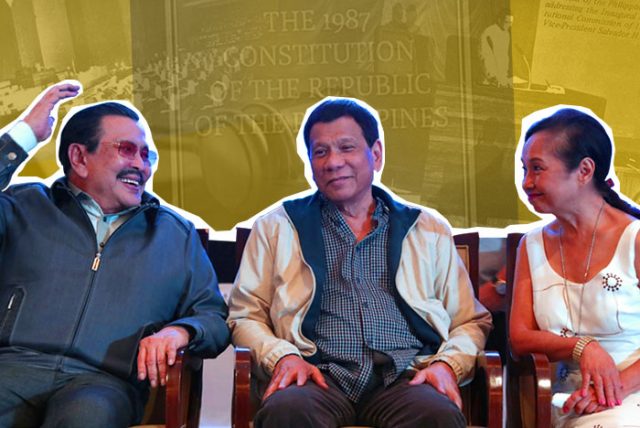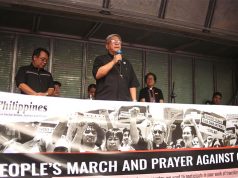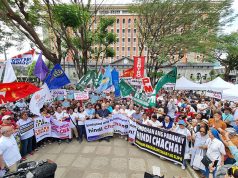For some critics and pundits, the recent Pulse Asia survey revealing that six out of 10 Filipinos do not want charter change has cast some doubt on the feasibility of constitutional revision.
March Pulse poll nos. on Charter Change suggests President’s no pied piper when it comes to the topic, as his repeated advocacy has moved the awareness needle only slightly while support has diminished although his popularity remains high. pic.twitter.com/dXgIDOEddC
— Manuel L. Quezon III (@mlq3) May 2, 2018
The Committee raises a point worth noting – majority of Pinoys, per Pulse Asia, think the Constitutition should be amended. But clearly too, a majority also does not support amendments at this point in time. https://t.co/4OdQwBuhf2
— oli r. (@ohlistic) May 2, 2018
President Rodrigo Duterte’s Consultative Committee however has since responded, questioning how the survey was framed and expressing confidence in a change in public perception once the proposed revisions have been presented.
The Duterte administration’s push for federalism is not the first charter change initiative endorsed by the head of state.
Aborted cha-cha from past administrations
1. ‘People’s Initiative’ under Ramos
The ’90s saw the rise of the People’s Initiative for Reform, Modernization and Action, an initiative to lift the one-term rule for presidents. Had it succeeded, the incumbent president during the time of the initiative Fidel Ramos would have been allowed to run for a second term.
Ramos was later criticized by former senators Juan Ponce Enrile and Aquilino Pimentel Jr. for his continued support of the initiative.
How did that turn out? PIRMA’s cause was eventually brought down in the landmark Supreme Court ruling in Santiago v. the Commission on Elections.
The ruling went in favor of the initiative’s principal detractor, the late Miriam Defensor-Santiago. The high court held that Republic Act 6735 or the “Initiative and Referendum Act” was insufficient basis for the COMELEC to hold a plebiscite based on people’s initiative on the Constitution.
2. Concord under Estrada
Ramos’ successor Joseph Estrada also tried his hand at reshaping the Constitution. Marketed as a solution to the country’s economic woes, Estrada’s Constitutional Correction for Development, or Concord contemplated the removal of constitutional restrictions on foreign ownership of land and key industries. According to Estrada, Concord would have aligned the Philippines’ economic competency with the emergence of liberalized trade and globalization at the time.
Around the turn of the millennium, Estrada announced that he would permanently abandon Concord by May 2001 should it have failed to gain public acceptance by then. Neither Estrada’s presidency nor Concord would live to see the deadline, as he was removed from power barely a month into the new year.
3. First attempt under Arroyo
The administration of Gloria Macapagal-Arroyo also saw the discussion on charter change come to life anew, with the former chief executive herself promising amendments to the Constitution by the end of her term.
Former House of Representatives speaker Jose de Venecia Jr. in 2005 claimed that there was an 85 percent chance a new constitution would be in place and that the Philippines would have transitioned to a parliamentary system by the end of Arroyo’s term. De Venecia had earlier discussed five possible courses of action for Arroyo, should she continue with her vision of constitutional reform.
4. Second attempt under Arroyo
By 2006, another people’s initiative had sprung up. The Sigaw ng Bayan and Union of Local Authorities of the Philippines pushed for a people’s initiative for the Philippines to shift to a unicameral parliamentary system.
The new initiative set its sights on the seemingly insurmountable task of getting the go-signal for a plebiscite by meeting the constitutional requirement of signatures of 12 percent of registered voters nationwide, representing 3 percent of voters in each congressional district.
The initiative eventually came to a screeching halt, despite the initiative supposedly having collected enough signatures. In what would be another landmark case, the Supreme Court found that the initiative’s backers failed to attach a draft of the proposed changes when they collected citizens’ signatures. This blunder invalidated the signatures.
The tribunal also seemingly closed the door on the people’s initiative method of reforming the Constitution. People’s initiative, as the court’s interpretation goes, can only amend part of the current charter and cannot revise or radically change it.
The shift to a unicameral government, according to the court, was a form of “revision,” and therefore could not be allowed.
Why is cha-cha still unrealized?
Former University of the Philippines president and political scientist Jose Abueva, who sat as chairperson of the Consultative Constitutional Commission during the Arroyo administration wrote a column on The Bohol Times discussing why her initiative failed.
Abueva points to multiple factors as having contributed to the initiative’s defeat:
- Arroyo’s general unpopularity with the masses,
- The plurality of political agendas obscuring the course,
- The lack of agreement on how charter change was to be achieved, and
- Ignorance and apathy of some involved in the process.










